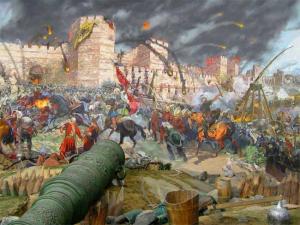Constantinople, which has existed since 330, is a symbol of Western civilization, being the capital of the Byzantine (Eastern Roman) empire for a long time, until the Ottomans invented the giant cannon.
According to the National Interest, the fall of the city of Constantinople (modern-day Istanbul, Turkey) in 1453 had a great influence in the West. This event ended the Middle Ages, caused the fall of the Byzantine Empire and paved the way for the rise of the Ottoman Empire to modern times. The world would have been much different if the Byzantines had successfully defended Constantinople.

The citadel of Constantinople, after more than 1,000 years of existence, has finally fallen.
On the way to building the most powerful empire in history, the Ottomans always considered the Byzantine Empire as the number one goal. Its geographical position as a bridge between Eurasia made Byzantine gradually fall under the hands of the Ottomans.
Initially, the Ottomans targeted Byzantine lands in Asia Minor. After annexing most of this land, they crossed the Dardanell Strait, gradually occupying and replacing the Byzantine Empire in the Balkans.
Having pacified the Balkans, the Ottomans returned to occupy the rest of Asia Minor, aiming to conquer the great capital Constantinople.
Constantinople, the capital of the Byzantine Empire, had a history of more than a thousand years and was for centuries the center of art, culture, and commerce in the Western world. The Ottoman sultans had long coveted this rich and splendid city, but never succeeded because of the towering wall blocking it.

To attack Constantinople, King Mehmet II used huge cannons.
After the death of his father, King Murad II in 1451, prince Mehmet II ascended the throne, directly directing the construction of giant cannons to break through the walls of Constantinople.
By the 15th century, Europeans had reached the pinnacle of gun-making. Mehmet II recruited the most talented gunsmiths at that time, assigning a Hungarian named Urban to oversee the creation of giant cannons weighing up to 20 tons , serving the campaign against Constantinople.
To transport the giant cannons, the engineers of that time also needed corresponding chariots. Many wooden horse-drawn carriages were broken because of the great weight of these giant guns.
The largest cannons in service of the siege were 8 meters long, firing bullets weighing 600 kg. Before the battle of 1453, Constantinople had stood up to 20 sieges, but the massive cannon gave Mehmet a great advantage.
For a 15th-century cannon to work effectively, gunpowder made from refined salt was needed. This salt is mixed with sulfur and charcoal to make gunpowder.
The gunpowder ingredients are carried separately and only mixed together before firing. The range of the giant cannon is up to nearly 1,000 meters, but for safety reasons, the amount of gunpowder is limited, firing at a distance of about 250 meters.

The fall of Constantinople marked the end of the Byzantine Empire.
The wooden shields kept the cannon operators away from archers or enemy muskets. Because of its massive size, the recoil of the gun is also relatively large.
After each firing, one must clean the gun, ensuring that they can be fired again. That means, each 20-ton gun only fires about 5 times a day.
The bullets of this stage cannon are made from metal with higher damage or hard stone. Thanks to these giant cannons, King Mehmed II, then only 21 years old, flattened the wall and entered Constantinople after only 53 days.
Emperor Constantine XI Palaiologos was killed on the spot. The Ottomans plundered for three days straight, enslaving more than 60,000 people. Many precious works of art were vandalized. All Christian statues were replaced by Islamic altars.
The great Haya Sophia turned into a mosque. King Mehmed II was impressed with the city of Constantinople, so soon after, he ordered the capital to be moved and renamed Istanbul (meaning the city of Islam).

